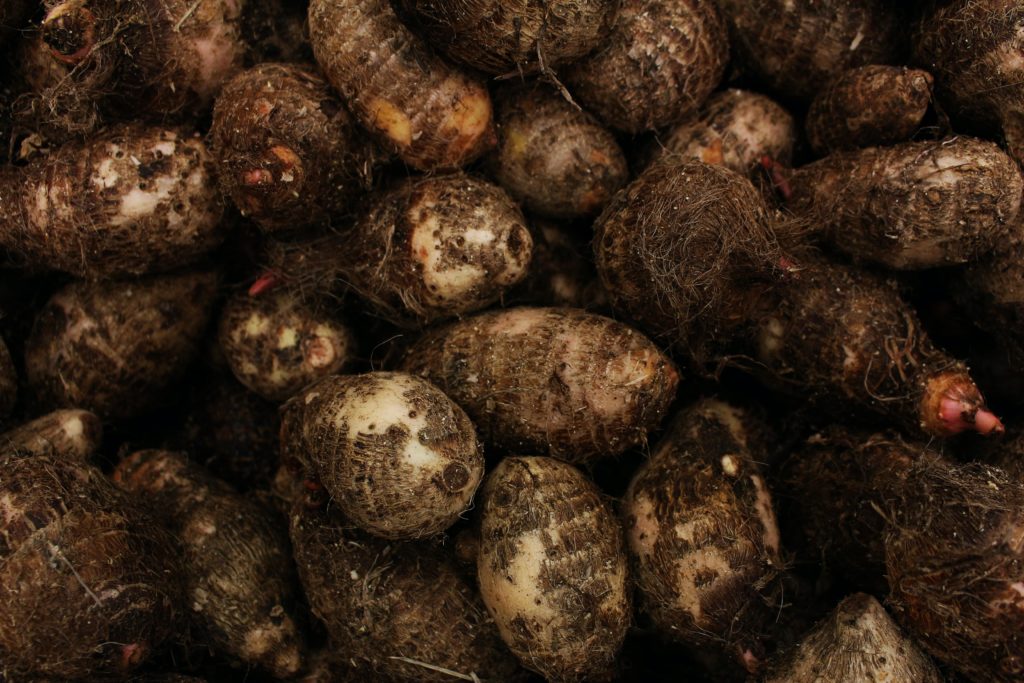There is a common confusion between a yam and a sweet potato among people. They are often used interchangeably. Both are indeed underground tuber vegetables, but they are very different from each other. Although they are distantly related, they belong to two different plant families.
In the following article, we will explain the key differences between yam vs sweet potato.
1. Yam vs Sweet Potato: What is a sweet potato?
The scientific name of sweet potatoes is Ipomea batatas. This is a starchy root vegetable. Currently, the largest producer of sweet potatoes is Noth Carolina but it was initially thought to be originated in Central or South America. The tuberous roots of a sweet potato plant are eaten as a vegetable just like a regular potato.
Sweet potatoes come in different colors such as yellow, orange, purple, brown, or red. They have smooth skin and are long in size. There are two major types of sweet potatoes.
- Dark-skinned, orange-fleshed sweet potatoes are soft and sweet with copper-brown skin and bright orange flesh. They are commonly found in the U.S.
- Golden-skinned, pale-fleshed sweet potatoes have light yellow flesh and tend to have a drier texture. They are less sweet than dark-skinned sweet potatoes.

In general, sweet potatoes are sweeter and moister than regular potatoes. They are also considered to be extremely robust vegetables because of their long shelf life. This allows them to be throughout the year. You can store it for up to 2-3 months if kept in a cool and dry place.
2. Yam vs Sweet Potato: What is a yam?
The scientific name of yam is Dioscorea and its origin is in Africa and Asia. However, in recent times, you can commonly find it in the Caribbean region and Latin America as well. There are over 600 varieties of yam and most of them(95%) are found in Africa.
Yams can grow larger than sweet potatoes. The sizes can grow up to 5 feet and weigh up to an impressive 132 pounds (60 kgs).
Some distinct characteristics of yams can help distinguish them from sweet potatoes.
Yams are cylindrical and have brown, bark-like, and rough skin. It is a little hard to peel off the skin, but it softens after heating. The flesh colors could be white, or yellow, and for mature yams, it could be purple or pink.
When compared to sweet potatoes, yams have a unique taste. They are less sweet and much more starchy and dry. They have a better shelf life than sweet potatoes. However, certain varieties store better than others.

It is difficult to find original yams in the U.S. They are mostly imported and rarely found in grocery stores.
3. Yam vs Sweet Potato: Why the confusion?
Enslaved Africans brought the local sweet potato called “nyami” to the U.S. This translates to “yam” in English. This is because it reminded them of true yams, a food staple of Africa.
Summary;
Both are indeed underground tuber vegetables, but they are very different from each other. Although they are distantly related, they belong to two different plant families. Enslaved Africans brought the local sweet potato called “nyami” to the U.S. This translates to “yam” in English. This is because it reminded them of true yams, a food staple of Africa.
The scientific name of sweet potatoes is Ipomea batatas. This is a starchy root vegetable. Currently, the largest producer of sweet potatoes is North Carolina but it was initially thought to be originated in Central or South America.
The scientific name of yam is Dioscorea and its origin is in Africa and Asia. However, in recent times, you can commonly find it in the Caribbean region and Latin America as well.
Read More: How to steam veg in the microwave?

